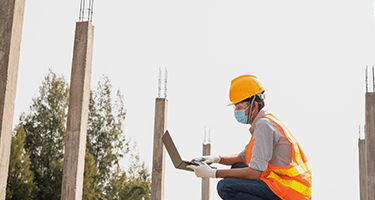Ultimate Guide to Roof Inspection Report Templates
As a roofing contractor, your business has a long list of forms that need to be completed on the job. This includes things like routine inspections, roof reports for clients, safety forms for employees, and a multitude of other related forms like work orders and estimates.
Instead of relying on paper forms, contractors are converting these processes into digital forms to help simplify workflows for everyone involved. This article covers an overview on roof inspection reports and links to the digital templates you can find provided by GoCanvas. Using our roof inspection report software, contractors can easily manage and share documents all from one centralized platform.
What is a roof report?
A roof report is a document that records the current condition of the structures and features of a roof. For example, a residential roof report would document the condition of a sloped roof or a flat roof for a homeowner, whereas a commercial roofing report would be created for the building owner of a commercial space.
In general, a roof report is designed to document findings from the inspection process that looks for any sort of structural damage, decay, or deterioration. The report summarizes everything the client or owner needs to know about the roof at that given point in time, so they can make appropriate repairs or plan for them in the future.
How do I write a roof inspection report?
With many different types of building structures and purposes, there are naturally many different types of roof reports. What to include in your roof inspection report will depend on many factors like the type of building, type of roof, client information, and more.
Rather than starting from scratch when writing a roof report, contractors can leverage pre-built templates and simply customize the form with any additional fields needed. Here is one example of the types of information that can be included when writing a basic roof report:
- Basic information – Includes things like the client name, location, report #, date of the report
- Roof notes – Includes things like estimated roof age and life expectancy, general roof condition, photos captured, and general roof condition notes
- Roof diagram – Documents the roof type, slopes, and other important elements or parts of the roof
- Signatures – Sign off with the roof inspector’s signature is included to make it official
What is included in a roof inspection?
The roof report sent to the owner or client is often a summary of key findings from the roof inspection. So what is included in a full roof inspection form? According to InterNACHI standards, a roof inspection should cover:
- The roof-covering materials;
- The gutters;
- The downspouts;
- The vents, flashing, skylights, chimney, and other roof penetrations; and
- The general structure of the roof from the readily accessible panels, doors or stairs.
The roof inspection standards from InterNACHI also note that the inspector should describe
the type of roof-covering materials and should report as in need of correction, such as observed indications of active roof leaks. Other standards note that the inspector is not required to:
- Walk on any roof surface.
- Predict the service life expectancy.
- Inspect underground downspout diverter drainage pipes.
- Remove snow, ice, debris or other conditions that prohibit the observation of the roof surfaces.
- Move insulation.
- Inspect antennae, satellite dishes, lightning arresters, de-icing equipment, or similar attachments.
- Walk on any roof areas that appear, in the inspector’s opinion, to be unsafe.
- Walk on any roof areas if doing so might, in the inspector’s opinion, cause damage.
- Perform a water test.
- Warrant or certify the roof.
- Confirm proper fastening or installation of any roof-covering material.
Roof Inspection Report Examples and Templates
With digital roofing report templates, employees in the field can fill out forms on a mobile device or tablet and have the information automatically sync back to the office for reporting. Roofers and roofing inspection companies can use roofing inspection management software from GoCanvas to help speed up the inspection and maintenance process. Here are some examples of roofing forms for contractors:
- Roof Inspection Checklist – As part of any building inspection, use this detailed checklist template provided in this mobile app to inspect and detail the condition of the roof and lead to early detection of any roof problem or damage (roof leaks).
- Roof Inspection Report – Provides a simple way for roof inspectors to track the results of their work and note any issues found during the inspection services. Once the roof inspection form template is complete, the roofing contractor can sign off on the results and have the homeowner or building owner sign off as well.
- Roofing Certificate of Completion – Use this app as a contractor when documenting successful completion of roofing for a building. Workers in the roofing industry can use this roof installation and repair form to generate new work completion forms once a job has been completed without having to return to the roofing company office.
Additional Forms for Roofing Contractors
Beyond roof inspections and reports, there are many other related roofing forms that can be used on the job site. Here are some other examples of how roofing contractors are using GoCanvas to streamline their operations:
- Work orders – Managing work is simplified when using software for generating work orders, dispatching the right workers, and tracking the status of work in progress. GoCanvas helps provide the tools to improve workflows between the field and office, with easy-to-use software for managing roofing work orders.
- Estimates and Invoices – Another opportunity to streamline work is by digitizing your roofing estimates and client invoices. GoCanvas enables you to provide a digital customer experience with PDF reports for estimates, and digital invoices that allow you to get paid faster. You can even sync GoCanvas with your accounting system to automate processes and you can also use our software to manage employee timesheets to track hours worked on client sites.
- Safety and Meetings – Roofing work requires working at heights and contractors need to ensure property safety protocols are followed on the job. GoCanvas can also function as a safety management system, with forms specifically designed for roofing safety. Use GoCanvas to provide fall prevention safety meetings, ensure proper PPE with checklists, and enable employees on the job to perform self inspections with checklists for fall protection equipment.
Get started with a free trial of GoCanvas to see all of the roofing contractor forms we have to offer. To learn more about the benefits of digital forms for the roofing industry, hear from Texas State Builders in the video below to see how they leverage work process software.

Stay in Touch!
About GoCanvas
GoCanvas® is on a mission to simplify inspections and maximize compliance. Our intuitive platform takes care of the administrative tasks, freeing our customers to focus on what truly matters – safeguarding their people, protecting their equipment, and delivering exceptional quality to their customers.
Since 2008, thousands of companies have chosen GoCanvas as their go-to partner for seamless field operations.

Check out even more resources

The Ultimate Guide to Quality Control Inspections
Managing a construction project is a complex and stressful process. Among other things, you have to coordinate project team members, materials, and equipment and ensure that contractors are not afflicted by the potential risks and hazards present at the construction site. That said, quality means different things to different people which is why you should…

Constructions Digital Transformation
Your competition is finding faster ways to capture data and get critical insights from the field into their existing systems. In short, they’re not going bigger, they’re getting smarter. In this 15-minute broadcast on the construction industry’s digital transformation, find out why the trend is to modernize workflows – and how you can stay ahead of the curve…

See how VIP Lighting optimized efficiency with GoCanvas
VIP Lighting is a retail lighting and electrical maintenance business that services over 10,000 retail locations all over Australia and New Zealand. Before GoCanvas, VIP Lighting had two separate systems that were impossible to integrate, leading to inefficiencies. GoCanvas made it easy to integrate their systems into single, centralized platform…